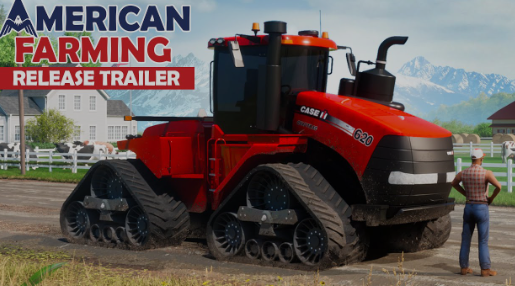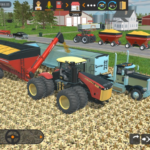American Farming 1.4.89 Gives us what we want in a farming game: Big Equipment, Big Fields, and American Buildings, all based on an American Map! With real-life Brands such as Case IH, Versatile, Unverferth, Brent, Landoll, and many more! And livestock operations, including Cow/Calf Farm, Cattle Feedlot, Farrow to Finish Hogs, and a Big Dairy Farm! All spread across 1,000+ Acres!

Choose between two different Starter Farms and work up to a Big Farm!
EQUIPMENT
– Choose from 75+ different vehicles & implements
– Customize your tractor to your liking with model sizes and tire options
– Tractors as large as Case QuadTrac 600 & Versatile DeltaTrac 620
– Big Implements like a Landoll 60ft Field Cultivator, Case IH 36 Row Planter
– Old Tractors like an International 1206 and International 1066
– Big Grain Carts such as the Balzer 2850 or Brent 2596
– ATVS & Dirtbikes to get around on the Farm
– Lowboy Trailers & Gooseneck trailers to haul equipment
FEATURES
– Realistic AI Workers
– Full Controler Support
– Tilt Control
– Full Tutorial & Help Menu
– Full Character Customization with 35+ different clothing options
LIVESTOCK
– Farrow to Finish Hogs: Start with piglets, raise them to Hogs
– Cow Calf: Feed the Calves out till they turn into a Yearling, and then finally a Steer
– Dairy: A complete Dairy farm with Calfs, Heifers, and Cows
– Liquid Manure can be injected with the Balzer Manure tanker to provide N, P&K
– Solid Manure can be spread with the H&S Spreader or Meyer Spreader

CROPS & FERTILIZER
– Corn, Soybeans, and Wheat
– Realistic grain drying at bin sites
– Crops require fertilizers: nitrogen, phosphorus, and potassium.
– Multiple forms of Nitrogen such as NH3, 32% UAN, Urea, Manure
– Realistic fertilizer optimization by rotating crops
American Farming! Download Now!
When it comes to American farming, the advent of technology has brought about significant changes over the years. One such revolutionary approach that has gained momentum is known as American Farming 1.4.89. So, what exactly is American Farming 1.4.89, and how does it differ from traditional farming practices?
American Farming 1.4.89 can be best described as a cutting-edge system that combines advanced technology with sustainable agricultural practices. This innovative approach focuses on maximizing productivity while minimizing environmental impact. By leveraging state-of-the-art techniques and machinery, farmers can optimize their operations, resulting in greater efficiency and profitability.
Unlike conventional farming methods, American Farming 1.4.89 places a strong emphasis on sustainability. It integrates precision agriculture techniques, which involve using GPS, sensors, and data analytics to precisely manage resources such as water, fertilizer, and pesticides. This targeted approach not only enhances crop yields but also reduces waste, making it an environmentally friendly alternative.
One of the key benefits of American Farming 1.4.89 is its ability to improve resource management. Through real-time monitoring and analysis, farmers gain valuable insights into soil health, moisture levels, and nutrient requirements. With this information at hand, they can make informed decisions regarding irrigation schedules, fertilization, and pest control, resulting in optimal resource allocation and reduced reliance on harmful chemicals.
Moreover, this modern farming approach promotes automation and robotics, streamlining various tasks and reducing labor requirements. Drones equipped with cameras and sensors are employed for aerial surveillance and crop monitoring, identifying potential issues before they escalate. Automated machinery assists in planting, harvesting, and even weed control, saving time and effort while enhancing overall productivity.
The integration of cutting-edge technologies in American Farming 1.4.89 has transformed the agricultural landscape, offering a promising future for both farmers and consumers. By adopting this approach, farmers can improve efficiency, reduce costs, and contribute to a sustainable environment.
American Farming 1.4.89 represents a remarkable shift in the agricultural industry. By harnessing the power of technology and sustainable practices, this innovative approach revolutionizes traditional farming methods. With its focus on precision, resource management, and automation, American Farming 1.4.89 paves the way for a more sustainable and prosperous future in American agriculture.
İndex
Revitalizing American Farming 1.4.89 : Innovative Solutions for a Sustainable Future
American Farming 1.4.89 Are you curious about the future of American farming? As we strive towards a more sustainable and eco-friendly world, it’s crucial to explore innovative solutions that can revitalize our farming practices. From embracing technology to implementing regenerative agriculture principles, there are exciting developments on the horizon that promise a brighter future for American farmers.

One groundbreaking solution that holds tremendous potential is precision agriculture. Imagine a farm where every inch of land is optimized for maximum productivity. Through the use of advanced sensors, drones, and data analytics, farmers can make data-driven decisions about crop planting, irrigation, fertilization, and pest control. By harnessing the power of technology, farmers can reduce waste, conserve resources, and increase yields, all while minimizing their impact on the environment.
Another remarkable approach gaining traction in the agricultural community is regenerative farming. Unlike conventional farming methods that deplete the soil, regenerative farming focuses on rebuilding soil health and promoting biodiversity. By employing techniques like cover cropping, rotational grazing, and composting, farmers can restore the natural balance of ecosystems while improving soil fertility and reducing erosion. This holistic approach not only enhances sustainability but also strengthens the resilience of farms to climate change and extreme weather events.
In addition to these technological and ecological advancements, diversification plays a pivotal role in revitalizing American farming. Encouraging farmers to embrace alternative crops and livestock can help reduce monoculture practices and enhance biodiversity. For instance, introducing specialty crops, such as organic herbs or heirloom varieties, can create new market opportunities and provide a buffer against price fluctuations. Likewise, integrating livestock into crop rotations can promote nutrient cycling, reduce synthetic inputs, and enhance soil health.
As we venture into the future, it is essential to support and invest in research and development to further drive innovation in American agriculture. By collaborating with scientists, policymakers, and farmers, we can develop and implement cutting-edge technologies, sustainable practices, and supportive policies that foster a thriving agricultural sector.
From Seed to Table: The Evolution of American Farming 1.4.89
Have you ever wondered how the food on your table came to be? The journey from seed to table is a fascinating one, showcasing the evolution of American farming practices throughout history. In this article, we’ll delve into the transformative changes that have shaped the way we produce and consume food in the United States.

In the early days of America, agriculture was primarily subsistence farming, with families growing crops and raising livestock to sustain themselves and their communities. It was a simple, labor-intensive process, relying on manual tools and traditional knowledge passed down through generations.
However, as the country grew and technology advanced, farming practices underwent a significant transformation. The Industrial Revolution brought forth innovations like mechanized farming equipment, such as the reaper and thresher, which increased productivity and efficiency. This allowed farmers to cultivate larger areas of land and produce surplus crops, leading to the emergence of commercial agriculture.
The introduction of synthetic fertilizers and pesticides in the mid-20th century marked another milestone in American farming. These chemical inputs revolutionized crop yields by combating pests and enriching soil fertility. While they undoubtedly boosted productivity, concerns over environmental impact and the potential health effects have led to a shift towards more sustainable farming methods in recent years.
Today, organic farming and sustainable agriculture are gaining momentum. Farmers are adopting practices that prioritize soil health, biodiversity, and natural pest control. Techniques like crop rotation, cover cropping, and integrated pest management are being embraced to reduce reliance on synthetic inputs and promote long-term sustainability.
Moreover, technological advancements continue to shape the future of American farming. Precision agriculture, for instance, leverages data analytics, drones, and GPS-guided machinery to optimize resource allocation and minimize waste. Vertical farming and hydroponics offer innovative solutions for urban areas with limited space, enabling year-round production in controlled environments.
The evolution of American farming practices signifies a dynamic relationship between humans, technology, and the environment. As we strive for a more sustainable future, it is crucial to appreciate the rich history that has paved the way for our modern-day food system. From humble seeds planted in the soil to a bountiful table, the story of American farming is an awe-inspiring testament to human ingenuity and our ever-evolving relationship with nature.
American Farming 1.4.89 : How Rural America is Embracing Resilience
In the heartland of America, where vast open fields and rolling hills stretch as far as the eye can see, a quiet revolution is taking place. It’s a story of determination, strength, and resilience. It’s about how rural America is defying the odds and embracing a new era of farming.
When we think of farming, we often picture idyllic landscapes and bountiful harvests. But the reality is far from picturesque for many rural communities. They face numerous challenges, including unpredictable weather patterns, limited access to resources, and market volatility. Yet, against all odds, these farmers are finding innovative ways to adapt and thrive.
One of the key driving forces behind this movement is the adoption of sustainable farming practices. With growing concerns about climate change and environmental degradation, farmers are realizing the importance of preserving their land for future generations. They’re implementing conservation techniques like crop rotation, cover cropping, and precision agriculture to maximize yields while minimizing their impact on the environment.
American Farming 1.4.89 But resilience in rural America goes beyond sustainable farming practices. It’s about embracing technology and innovation to overcome longstanding obstacles. Farmers are leveraging the power of data analytics, satellite imagery, and drones to make informed decisions about planting, irrigation, and pest control. These advancements not only increase efficiency but also reduce costs and improve overall productivity.
Furthermore, rural communities are coming together to support each other in times of need. The spirit of cooperation and collaboration is alive and well, with farmers sharing knowledge, equipment, and resources to navigate the challenges they face. They understand that by working together, they can achieve more than they ever could alone.
This newfound resilience in rural America is not only transforming the agricultural landscape but also revitalizing entire communities. It’s creating opportunities for young farmers to stay in their hometowns, fostering economic growth, and preserving the rich cultural heritage that defines these regions.
The Rise of Organic Agriculture: Transforming American Farming 1.4.89
Have you ever wondered about the origins of the food on your plate? In recent years, there has been a remarkable shift in American agriculture towards organic farming. This trend is transforming the landscape of farming practices across the nation. Organic agriculture, with its emphasis on sustainability and natural methods, is gaining momentum and revolutionizing the way we grow our food.
American Farming 1.4.89 One of the significant driving forces behind the rise of organic agriculture is the increasing awareness among consumers about the impact of conventional farming on the environment and human health. People are becoming more conscious of the chemicals and pesticides used in conventional farming, which can have harmful effects on the soil, water, and even the food we consume. As a result, many individuals are opting for organic produce to minimize their exposure to these potential risks.
Organic farming embraces a holistic approach that prioritizes soil health and biodiversity. Farmers who practice organic agriculture work hand in hand with nature, utilizing techniques like crop rotation, composting, and natural pest control methods. These methods enhance soil fertility, preserve water quality, and promote a healthier ecosystem overall. By avoiding synthetic fertilizers and pesticides, organic farmers reduce their environmental footprint and contribute to the long-term sustainability of our planet.
Furthermore, the demand for organic products is skyrocketing, creating new opportunities for farmers across the country. The market for organic produce has expanded significantly in recent years, and consumers are willing to pay a premium for organic goods. This shift in consumer behavior has motivated many farmers to transition from conventional to organic farming practices, as they recognize the potential economic benefits and the chance to tap into a growing market.
The transformation of the American farming landscape is evident as more and more acres are dedicated to organic production. According to the United States Department of Agriculture (USDA), the number of certified organic farms in the country has been steadily increasing over the past decade. This surge in organic agriculture signifies a shift towards a more sustainable and environmentally friendly future for American farming.
AMERİCAN FARMİNG V0.4.83 MOD APK – PARA HİLELİ 2024
Bizi Google news üzerinden takip ederek, güncel ve son sürüm oyun ve uygulamalar hakkında bilgi alabilirsiniz.















